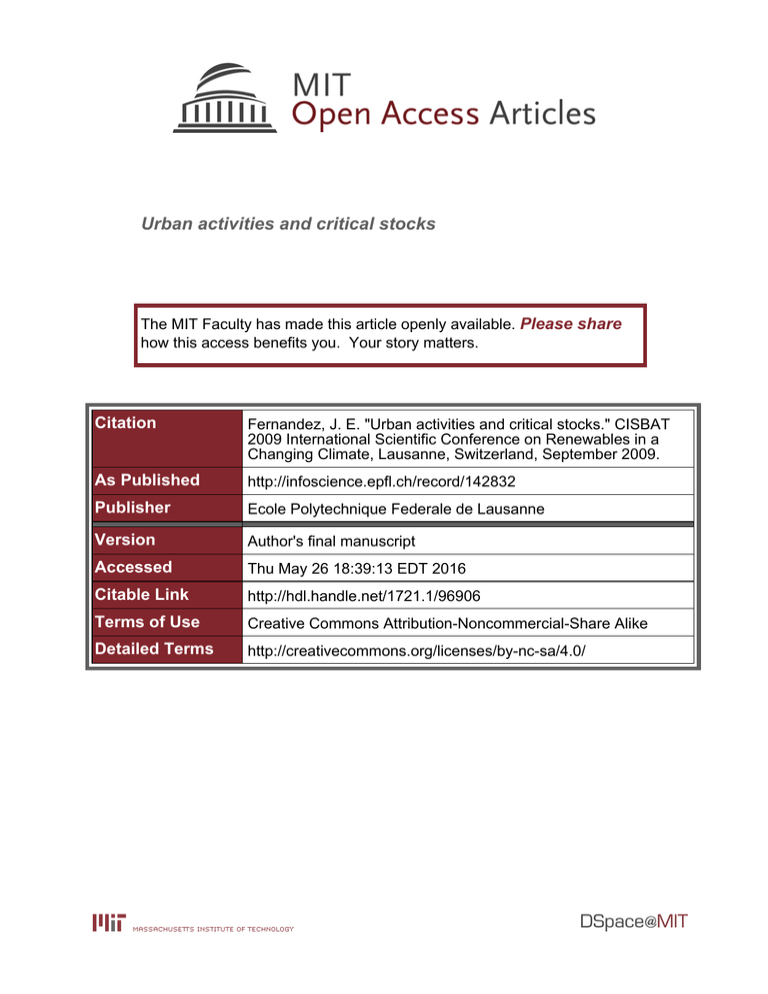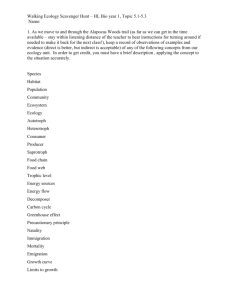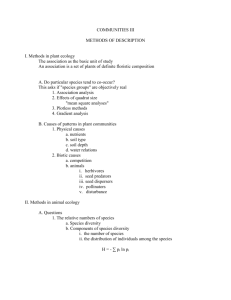Urban activities and critical stocks Please share
advertisement

Urban activities and critical stocks The MIT Faculty has made this article openly available. Please share how this access benefits you. Your story matters. Citation Fernandez, J. E. "Urban activities and critical stocks." CISBAT 2009 International Scientific Conference on Renewables in a Changing Climate, Lausanne, Switzerland, September 2009. As Published http://infoscience.epfl.ch/record/142832 Publisher Ecole Polytechnique Federale de Lausanne Version Author's final manuscript Accessed Thu May 26 18:39:13 EDT 2016 Citable Link http://hdl.handle.net/1721.1/96906 Terms of Use Creative Commons Attribution-Noncommercial-Share Alike Detailed Terms http://creativecommons.org/licenses/by-nc-sa/4.0/ Urban activities and critical stocks J. E. Fernández Associate Professor, Building Technology Program, Massachusetts Institute of Technology, Room 5-418, 77 Mass. Ave, Cambridge MA 0213, USA. ABSTRACT Assessing contemporary society´s burden on the planet has been an ongoing project of many research teams in many disciplines. The recent emergence and proliferation of efforts to understand the role that cities play has led to the near-simultaneous development of various frameworks, methodologies and working models that capture urban resource flows and account for expenditures by industry, households and infrastructure networks; including power, water, and transportation. This paper introduces an urban resource flow model and describes the organization of its various elements with respect to two key fields; urban economics and ecology. The central organizing principle of this framework is the delineation of three fundamental urban activities occurring within a context of socioeconomic and biogeochemical material and energy transfers. These three urban activities are the direct link to key theoretical elements of both urban economics and ecology and thus facilitate a cooperative relationship between the evolving understanding of urban resource flows and economic and ecological urban thinking. INTRODUCTION The study of cities has been an ongoing preoccupation of philosophers and scientists since the widespread phenomena of urbanization was noted by ancient philosophers and poets. The seemingly inevitable development of cities everywhere on earth, in every society and culture throughout time has elicited commentary regarding the nature of agglomeration in social, political and economic terms. Aristotle remarked that “...[t]he city belongs among the things that exist by nature, and…man is by nature a political animal" [1]. Throughout the 19th and 20th centuries, several strands of thought wove together to eventually bring us an understanding of urban centers as complex dynamic systems that act as political and economic foci for regions and nations and are regulated by resource flows serving a welldefined set of fundamental urban activities. This understanding came as a result of a convergence of political, ecological, and social ideas spurred on by work in the sciences, especially as related to the societal demands on energy and material resources [2, 3, 4, 5, 6]. It is not surprising that this multi-faceted concept of the city began to emerge as the world was undergoing the fundamental transition from an agrarian-based sociometabolic regime to an industrial-capitalist regime based on nonrenewable fossil fuel material and energy resources [7]. During the early 20th century, the idea that societies needed to understand and carefully manage their growth, especially as manifest by sprawling urban regions was beginning to be articulated by planners, ecologists, economists and others. For example, E.P. Odum, the American ecologist, was one of the first to understand that the rural-urban interface needed special attention. In 1969, he wrote, “...[we] have not yet risen to the challenge of the urbanrural landscape, where lie today's most serious problems.” [8]. For many years now there has been a clear determination that the transformational effects of anthropogenic activities can be found in every biome on earth [9]. Recently, a proliferation of studies that characterize global resource flows has led to a better understanding of the network of material and energy exchanges that serve contemporary society and the ramifications for the environment [10, 11, 12]. We now have large scale studies that are, for the first time, tracing the extraction and consumption of the world´s resources during much of the period of human history since, and sometimes before the industrial revolution [7, 13]. Most recently, a renewed focus on cities has been prompted by the growing awareness that the majority of the global population is now urban and, as a result, global resource consumption, carbon emissions and waste dispersion is concentrated in cities [14]. This awareness has catalyzed an array of research and implementation projects around the globe that are striving to meet the needs of a growing urban population while taking on the challenges of global warming, critical resource shortages and the political and social realities of a new urban century [15]. The research work highlighted here and forming the organization of this paper takes as its departure two themes; the metabolic nature of urban systems, and the resource flows serving three fundamental urban activities. These are treated in the following sections: URBAN METABOLISM, and URBAN ACTIVITIES AND RESOURCE FLOWS. URBAN METABOLISM Urban metabolism is the study of material and energy flows arising from urban socioeconomic activities and regional and global biogeochemical processes. The characterization of these flows and the relationships between anthropogenic urban activities and natural processes and cycles defines the behavior of urban production and consumption [16, 17, 18]. The primary methods that are being adopted for assessing the complex dynamics and resource intensity of an urban zone are stock flow models serving a system dynamics (SD) architecture regulated by the conventions of material flow analysis (MFA). System dynamics is well known for its utility to organize and analyze the various elements of a complex scenario [19, 20]. In recent years, MFA has been used to account for the actual physical flows devoted to the urban socioeconomic engine resulting in several studies that attempt to characterize these flows [21]. Urban metabolism models are derivatives of national economy-wide material flow analysis models [22, 23]. While national-scale MFA methodologies are now well-established and offer clear conventions on border designation, flow characterization, accounting methods and definitions, the urban metabolism method has not reached consensus on these and other elements for the modeling of urban resource flows. This lack of consensus is a major motivator behind the work presented here. While there are many elements that require attention in the formulation of a robust MFA for urban zones, a critical aspect of further development involves identifying and providing the best linkages between urban-scale flow accounting and the prevailing theoretical frameworks of both urban economics and ecology. URBAN ACTIVITIES AND RESOURCE FLOWS The derivation of key linkages between the urban metabolism framework and urban economics and ecology requires a brief outline of the relevant elements of these fields and an explanation regarding their relationship to physical accounting. Understanding the economies of cities and the ecologies that feed and reside within them would seem to be important aspects of urban theory and research. Yet, economists and ecologists alike are latecomers to the study of cities, having been preceded by historians and sociologists. Urban economics The core question for urban economics is why do people choose to locate in dense settlements? The answers thus far are derived of a fundamental cornerstone of urban economic theory; that of spatial equilibrium. Cities attract people, firms, and construction in a seemingly mutually beneficial equilibrium contained within a relatively small spatial extent. Cities exist because of the dynamics behind this spatial equilibrium. It has been the work of the urban economists and economic geographers to explain the mechanics of this equilibrium [24]. It turns out the governing attribute of urban spatial equilibrium is that a benefit in one location must be accompanied by an equilibrating cost in that same location. That is, urban economies lack the presence of arbitrage opportunities [25, 26]. In addition, the utility of a location can be shown to be: Utility = Income + Amenities – Housing costs – Transportation costs The concept of spatial equilibrium has led to the development of models that attempt to illustrate the dynamic relationships between wages, transportation and housing costs and amenities, all while balancing centrifugal and centripetal forces in the maintenance of the urban economy [24]. Various models have been empirically verified to show that holding income and amenities constant leads to a close correlation between housing and transportation costs, and similarly, holding transportation costs and amenities constant leads to a close correlation between income and housing costs (for example, the Alonso-Muth-Mills model) [27]. The usefulness of this conceptual framework is the ability to consider, for example, the possibility that building integrated and community-owned renewable energy production and storage within a city may be classified as an amenity by the residents of that urban district. In urban economic terms this would correlate directly with housing, transportation costs and income levels for that district. Significant work is now trained on the relationship between urban development and environmental issues [for example, 28]. Urban ecology Urban ecology has been focused on urban ecosystems with the intent to understand and eventually shape the interaction between socioeconomic urban activities and natural ecosystems [29]. Closely related to the work in urban and regional planning that addresses the urban-nature interface, urban ecology derives its theories and methods from linking the science of natural ecosystems with sociological studies of urban systems and form [30, 31, 32]. Some of the most intriguing and potentially useful work to come out of this field are associations between urbanization and certain transformational effects on biogeochemical processes [14, 33]. For our purposes, the link between key attributes of urbanization, such as density and impermeable land cover, and particular effects on hydrological, carbon, nutrient, oxygen and other cycles is particularly useful here. The MFA/SD approach uses the latest research that has shown robust causal links between urbanization and ecological effects [34, 35]. Urban activities: Products, Buildings and Transport Several models that attempt to describe resource flows within the economic and ecological context of urban regions have been developed (notably UrbanSim/OPUS). The use of these models for detailed analysis of specific cities and their regions is well-established. However, robust simple models that generalize dynamics of urban systems based on an accounting of resource flows are not well developed. The use of these models as avenues towards better understanding of urban typologies and characteristic urban resource consumption profiles is needed. The model presented here delineates energy and material flows devoted to three broadly inclusive sets of urban activities (see Fig. 1): 1. the provision of habitable space (the built environment, ua1), 2. the provision of goods and services of all types (products, ua2) and, 3. the provision of the movement of goods and people (transportation, ua3). These urban activities are formulated as provisions of urban living and working. That is, the city is conceived of as a collection of necessary and sufficient provisions of habitable space, goods and services (especially air, water, food, critical materials and waste removal) and transportation. This formalization is intended to provide a robust intellectual and operational link to the main theoretical assertions of economic economics and urban ecology. Specifically, spatial equilibrium is organized according to the production of firms and workers (goods and services) and the costs of housing (built environment) and transportation. These explicit links lend important guidance in the ongoing project to link economic models of urban growth and development with models of resource consumption that take into account natural cycles and biogeochemical processes. Figure 1. represents this link as a flow diagram regulated by dynamic system relationships. Figure 1: Urban metabolism material flow analysis model (MFA). DISCUSSION The framework above is organized into a stock-flow model using software that incorporates both system behavior and resource flows (energy and materials, using Anylogic® system dynamics software). Air, water, energy and fuels, and mineral and biomass materials are accounted for as they are required by the three urban activities listed above. Resource intensities are defined as densities of consumption devoted to fixed and running resource expenditures. Metabolism is defined as per capita resource consumption related to the provision of goods and services, the built environment and transportation. Individual composite resource intensity indices are defined for each class of urban activity. In this way, the three urban activities can be assessed in terms of their aggregate and per capita resource demands. Critical stocks are defined as those required to maintain a minimum urban metabolism for the health and safety of urban residents. The constraints of this paper do not allow a full rendering of results from simulation runs. ACKNOWLEDGEMENTS The authors would like to thank the generous support of the MIT Portugal Program, the Intituto Superior Técnico of Lisbon, Portugal and Professor Paulo Ferrão in particular. REFERENCES 1. Aristotle. The Politics. Translated by C.D.C. Reeve. Hackett Publishing, Indianapolis, USA, 1998 2. Geddes, P. 1885. An analysis of the principles of economics. Proceedings of the Royal Society of Edinburgh, March 1884. London: reprinted by Williams and Northgate. 3. Soddy, F.: Matter and energy. Oxford University Press, Oxford, 1912. 4. Wolman, A. The metabolism of cities. Scientific American, Vol 213, pp 179-190, 1965. 5. Fischer-Kowalski, M.: Society´s metabolism: The intellectual history of Materials Flow Analysi, Part I, 1860-1970. Journal of Industrial Ecology, Vol 2, pp 61-78, 1998. 6. Fischer-Kowalski, M. and W. Hüttler: Society´s metabolism: The intellectual history of Materials Flow Analysi, Part II, 1970-1998. Journal of Industrial Ecology, Vol 2, pp 107136, 1999. 7. Krausmann, F., Fischer-Kowalski, M., Schandl, H. and N. Eisenmenger: The global sociometabolic transition. Journal of Industrial Ecology Vol 12, pp 637-656, 2008. 8. Odum, E.P.: The strategy of ecosystem development. Science, Vol 126, pp 262-270, 1969. 9. Vitousek, P.M., Mooney, H.A., Lubchenco, J. and J.M. Melillo: Human domination of earth´s ecosystems. Science, Vol 277, pp 494-499, 1997. 10. Schandl, H. and N. Eisenmenger: Regional patterns in global resource extraction. Journal of Industrial Ecology, Vol 10, pp 133-147, 2006. 11. Behrens, A., Giljum, S., Kovanda, J. and S. Niza: The material basis of the global economy: Worldwide patterns of natural resource extraction and their implications for sustainable resource policies. Ecological Economics, Vol 64, pp 444-453, 2007. 12. Weisz, H. and H. Schandl: Material use across world regions. Journal of Industrial Ecology, Vol 12, pp 629-629-636, 2008. 13. Erb, K.-H., Gingrich, S., Krausmann, F. and H. Haberl: Industrialization, fossil fuels, and the transformation of land use. Journal of Industrial Ecology, Vol 12, pp 686-703, 2008. 14. Kaye, J.P., Groffman, P.M., Grimm, N.B., Baker, L.A. and R.V. Pouyat: A distinct urban biogeochecmistry? Trends in Ecology and Evolution, Vol 21, pp 192-199, 2006. 15. Fernández, J.: Beyond Zero. Volume, Archis Foundation: The Netherlands, Vol 18, pp 613, 2008. 16. Kennedy, C. and R. Lifset: "Urban metabolism." In: Encyclopedia of Earth. Eds. Cutler J. Cleveland (Washington, D.C.: Environmental Information Coalition, National Council for Science and the Environment). [First published in the Encyclopedia of Earth April 15, 2007; Last revised April 18, 2007; Retrieved June 01, 2009]. http://www.eoearth.org/article/Urban_metabolism 17. Baccini, P. and P.H. Brunner: Metabolism of the Anthroposphere. Springer-Verlag, Berlin, 1991 18. Decker, H., S. Elliott, F.A. Smith, D.R. Blake, and F. Sherwood Rowland: Energy and material flow through the urban ecosystem. Annual Review of Energy and the Environment, Vol 25, pp 685-740, 2000. 19. Forrester, J.: Urban Dynamics. Pegasus Communications: Waltham, MA, 1969 20. Sterman, J.D.: Business Dynamics: Systems thinking and modeling for a complex world. McGraw Hill Higher Education: New York, 2000 21. Schulz, N.B.: The Direct Material Inputs into Singapore’s Development. Journal of Industrial Ecology, Vol 11 pp 117-131, 2007. 22. EUROSTAT: Economy-wide material flow accounts and derived indicators. A methodological guide. Statistical Office of the European Union, Luxembourg, 2001 23. Hinterberger, F., Giljum, S. and M. Hammer: Material Flow Accounting and Analysis (MFA): A valuable tool for analyses of society-nature interrelationships. SERI Background Paper, Nr.2, Sustainable Europe Research Institute: Vienna, 2003. 24. Fujita, M., Krugman, P. and A. Venables: The Spatial Economy. MIT Press: Cambridge, 1999 25. Glaeser, E.L.: The Economic Approach to Cities. Harvard Institute of Economic Research Discussion Paper No. 2149; KSG Working Paper No. RWP08-003, 2008. Available at SSRN: http://ssrn.com/abstract=1080294 26. Glaeser, E.L.: Cities, Agglomeration and Spatial Equilibrium. Oxford University Press: Oxford, 2008 27. Pflüger, M.: A simple, analytically solvable, Chamberlinian agglomeration model. Regional Science and Urban Economics, Vol 34, pp 565-573, 2004. 28. Glaeser, E.L. and M.E. Kahn: The greenness of cities: Carbon dioxide emissions and urban development. Harvard Institute of Economic Research Discussion Paper No. 2161, 2008. Available at SSRN: http://ssrn.com/abstract=1204716 29. Grimm, N.B., Faeth, S.H., Golubiewski, N.E., Redman, C.L., Wu, J., Bai, X. and J.M. Briggs: Global change and the ecology of cities. Science, Vol 319, pp 756-760, 2008. 30. Pickett, S.T.A, Cadenasso, M.L. and J.M. Grove: Biocomplexity in Coupled Natural– Human Systems: A Multidimensional Framework. Ecosystems, Vol 8, pp 225-232, 2005. 31. Pickett, S.T.A., Cadenasso, M.L., Grove, J.M., Nilon, C.H., Pouyat, R.V., Zipperer, W.C. and R. Costanza: Urban Ecological Systems: Linking Terrestrial Ecological, Physical, and Socioeconomic Components of Metropolitan Areas. Annu. Rev. Ecol. Syst., Vol 32, pp 127–57, 2001. 32. Grimm, N.B., Grove, J.M., Pickett, S.T.A. and C.L. Redman: Integrated Approaches to Long-Term Studies of Urban Ecological Systems. BioScience, Vol 50, pp 571-584, 2000. 33. Clergeau, P., Jokimäki, J. and R. Snep: Using hierarchical levels for urban ecology. Trends in Ecology and Evolution, Vol 21, pp 660-661, 2006. 34. Alberti, M.: The effects of urban patterns on ecosystem function. International Regional Science Review, Vol 28, pp 168-192, 2005. 35. Alessa, L. and F.S. Chapin III: Anthropogenic biomes: a key contribution to earth-system science. Trends in Ecology and Evolution, Vol 23, pp 529-531, 2008.




